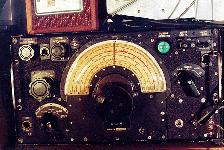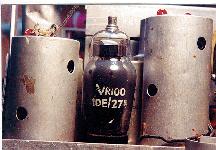The James Bond Stuff
Recently declassified information about World War two attempts to decipher information encrypted by the Enigma cipher machine brought to light the world's first programmable electronic computer. The 'Colossus'was one of ten assembled at Bletchley Park and each contained fifteen hundred vacuum tubes. PBS recently did a special on the goings on at the remote English country house, look for Nova:"Decoding Nazi Secrets" on PBS.
One of the 'Colossus' machines is currently being rebuilt. See Bletchley Park "Britain's best kept secret." and WW2 Codes and Ciphers.
The 24A
The 24A The very first commercially available tetrode,mentioned here only because I have a few of them.
Bill Hennigan wrote:
"Saw your web page and saw the type 24A tube mentioned.If I recall
correctly the type 22 is the first commercial tetrode.The
difference between it and the 24A, is that the 24A was built for
use with an AC Filament voltage, and has an indirectly heated
cathode. The type 22 has no cathode, the filament is the emitter,
and made for use with a battery filament supply.
73"
The "Beam Power" Tube
The "Beam Power" R.F. Amplifier Tube and the British Marconi R1155A Some time ago I posted a request here for information on the 'beam power' R.F. amplifier tubes supposedly used in my Wordl War 2 vintage British Marconi R1155A radio receiver. A summary of responses is below, quite a few have have pointed out that the VR100 tubes used in the R1155 series of radios were not actually beam power R.F. tubes.
Re Beam Power R.F. Amplifier Tubes:
( They do exist but not in the R1155.)
Mr. Valve rep Hugh Stegman (NV6H) wrote:"Sure. Real big in PA design at one time, because you supposedly didn't need to neutralize them. (Others will tell you that you really should neutralize everything on general principles... :-) )
...6146, a sort of hot-rod 90 watt RF power tube vaguely inspired by the 6L6, is a beam power tube. It's a good tube. They still make them, though the milspec ones are getting a bit rare. There are a lot of Collins radios still in service..."
Re the R1155A:
Thanks to Humphrey Brown for providing the following source of manuals,as well as some arcane lore on the VR100 tubes:
Mauritron Technical Services 8 Cherry Tree Road, Chinnor, Oxfordshire. OX9 4QY. Tel. (0844) 351 694, Fax (0844) 352 554.
"These guys claim to have any and all tech manuals on anything electronic. I sent them a fax asking if the had the schematic for R1155A, ordered the manual and paid by credit card. All easy. come to think of it they may well be on the net now...let's go look... Humphry"
Reader John Gibson , whose first love was an R1155A, mentioned that the R1155A's were originally built for installation in Halifax Bombers, and apparently mine still has the original cork lined metal cabinet. My R1155A in the picture has a replacement 'slow motion' tuning dial bought in surplus years ago and originally meant for an R1155N which does confuse identity somewhat..
Many R1155A's wound up in surplus stores after the war ended and became a favorite receiver for radio amateurs. Select either of the images below for an enlarged view of the R1155A and one of it's R.F. amplifier tubes. The '1155 was receiving WWV on 5 MHz. when the picture was taken, tuning range is from 75 KHz. to 18 MHz. Note the hand lettering on the VR100 tube which may have had something to do with wartime shortages.
Please e-mail schmaus@ee.ualberta.ca if you would like to contribute to this growing collection of R115A lore.
Jimmy, SM2BYW sent a picture of his ham shack including his refurbished R1155A. It's here. (52K JPEG)
Geissler Tubes
Hydrogen Thyratrons
Hydrogen Thyratrons The laser guys next door have used hydrogen thyratrons in high power pulse applications. They have also blown the main building fuses,but that's another story.
Hydrogen Thyratrons are the Weber Carburetors of vacuum tubes,you can see little capscrews and things through the (usually very large) tube envelope. Hydrogen thyratrons typically use a heater to liberate hydrogen inside the tube (In addition to the filament supply.),and are capable of switching kilovolts in nanoseconds. Needless to say they are very expensive. Typical part numbers are 8614/HY5 ,7782/HY6,7665/HY60,and the HY61. There are also some references to Hydrogen Thyratrons in John Pasley's High Power Switch section.
Our hydrogen thyratrons were made by EG & G 's electro-optics division around 1976. The EG & G Home Page contains a fascinating history section as well as information on their many products. EG & G's sales Dep't. Fax number is: (508)745-0894.
Industrial, Analytical,
and X-Ray Tubes (Richardson)
Magic Eye Tubes
Nuvistors
Nuvistors are about the physical size of a thimble.Some cold-cathode nuvistors still are used in high temperature Geophysics applications.
Rife Technologies
A former employee brought a Rife tube in for vacuum evaluation a while back. I had to tell him about gettering, sputtering, etc.
Sub Miniature ("Hearing Aid") Tubes
Thanks to Dennis Branch, of 'Radio Classified' for e-mailing information in the first paragraph below.
"Typically encased in a flattened glass tube about .5 X 1 X 4 cm. dimensions,sub mini's were developed in WWII for use as proximity detectors in anti-aircraft shells. After the war, they were put to many uses. One of them was small portable radios, which are very rare today. I'm fortunate enough to have a Hoffman "Nugget", which uses those tubes. The radios were only made over a one-year period, as transistor radios came out the following year, and very few were made at that. Hearing aids was another application....(Dennis Branch)"
Sub minis were also used in some military equipment , and a few types of subminis also found wide use as electrometer amplifiers,e. g. the CK5886 hearing aid tube was often hand picked for use as an electrometer. I remember building a super regenerative receiver around a surplus sub-mini when I was a high school student- it was confiscated by the technophobe school librarian for a time but that's another story along with the CK722 transistor that went up in smoke when it's 9 volt maximum rating was exceeded.
There is a CK722 web page here.
Circuit boards from the Avro Arrow were full of subminiature tubes used in analog computers of the time. A full size mock-up of the Arrow was constructed by a Wetaskawin man,Alan Jackson , and used in the CBC production "The Arrow". The nose section was originally on display at the Aviation Hall of Fame next to the Reynolds Transportation Museum in Wetaskawin,Alberta. CBC's "The Arrow" link is here.
Arrow Alliance Arrow engineer Peter Zuuring would like to get an Arrow flying for the hundredth year of aviation in Canada, Many old myths such as the one about Deifenbaker killing the Arrow are debunked on the Arow-Alliance site.
The Traveling Wave Tube
"Also, a very interesting Vacuum tube is the TWT, (travelling wave tube), used for high power (~40 watts and up) microwave amplification. These are extensivly used on commercial communications satellites, since they are lighter and more efficient than their solid state counterparts."..Jody Byram
Triton ETD ( formerly ITT electron Technology) make TWT's and have some interesting technical information on their web page.

